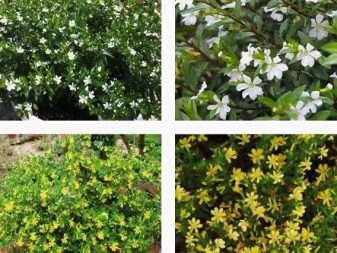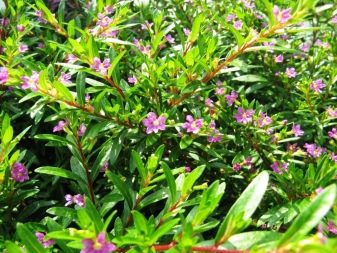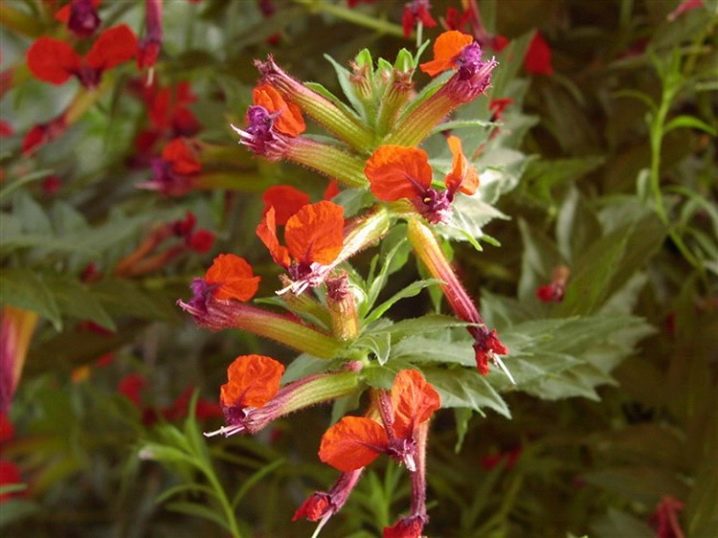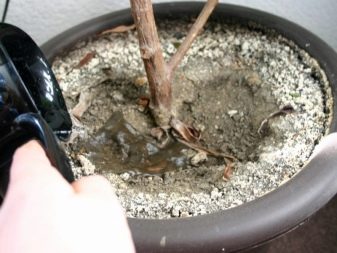Kufeya: description of species, planting rules and care features

A plant called kufeya is a representative of the family of the Loose family. This herb can be both annual and perennial. And also kufeya is grown in the form of shrubs. The natural habitat of flowers is the South American continent.

Description
Translated from the Greek language, kufeya means "crooked", it is believed that the plant got such a name because of the fruits, which have a curved shape. Kufeya is a compact ornamental plant. It owes this to its strong stem, to which many small leaves are attached, they have an oblong and solid shape, and their tops are pointed towards the edge. The flowering period of kufei is considered to be the beginning of the spring season, and it lasts until mid-autumn. The gaps between the leaves are filled with chic inflorescences, which give a special charm to the plant. Basically, the flower bowl consists of 6 petals, has a porous structure. The color scheme of flowers is quite varied. Most varieties of kufei are not replete with contrasting shades, but, on the contrary, are painted in gentle tones.


The crop is ideal for both outdoor planting and looks good as a houseplant. Kufeya is usually cultivated as an annual plant when it comes to planting in the garden. The plant is capable of surviving the winter season only if it grows in the southern part of Russia. Some varieties of flowers can withstand up to 12 degrees below zero. Indoors, it can be grown for several years. The main difficulty in growing such flowers in our area is the heat-loving nature of kufei. It is best to grow them in flowerpots or any other container.
In the warm season, such a plant can be used to decorate a garden or balcony, and with the onset of cold weather, it can be placed back in a warm room environment.


Types and popular varieties
We present to your attention a list of the most popular varieties of kufei.


Kufea hyssopolis
The plant came to us from distant Mexico. Due to its natural range, kufei is a very thermophilic plant. The advantage is that rain does not pose much of a threat to the plant. And also kufeya easily tolerates gusts of wind. This ornamental crop is quite compact in shape, usually cultivated in the form of small bushes.
In height, representatives of the hyperella kufei do not exceed 50 centimeters. Shoots are very branched and sinuous. Usually grown indoors. The leaves on the stems are arranged in the opposite order and appear as small petioles. Lanceolate leaves are colored green. Flowers are small and grow in the axillary part of the leaves. The petals are painted in various shades of gentle tones.


Kufeya fiery red
In height, representatives of this variety can reach a maximum of 40 centimeters. The lanceolate leaves of the shrub are oblong, can reach 5 centimeters in length, and their width can be 2-3 centimeters. In the arrangement of leaves on the shoots, the plant has the same order as in the previous variety of kufei. They are painted dark green. The flowers of this kufei are small, their diameter reaches a maximum of three centimeters.
The plant owes its name to the color of the petals of the bud.They have a fiery red color, their curved part is painted in delicate purple.


Llavea
Like many representatives of this species, the laveya is very fond of sunlight. It can grow even in deserts, as it does not need constant moisture and adapts perfectly to arid regions. The origin of this species is natural, unlike many other representatives of kufei. The average height of the bushes can be 30 centimeters.
The leaves of the kufei are elongated and painted in dark green tones. The edges of the leaves are decorated with small white villi. The buds are considered large, the length of one flower can be 2.5 centimeters. The flowers are painted a deep red, and the curved edges have a purple tint.

Shriracha
Typically, these representatives are colored in delicate colors, such as pink, raspberry or lilac. Representatives of this variety are very fond of high temperatures. The hybrids of such kufei are considered to be quite young varieties. Grows effectively at temperatures above +20 degrees. But cool summers won't be a big problem for flowers. The size of the bushes to some extent depends on the growing area, but on average they can reach a height of 30 centimeters.
Unlike its relatives, the appearance of the plant is not curved, on the contrary, this kufeya is erect.


Landing
As already mentioned, almost all varieties of kufei are very fond of warmth. Therefore, you should carefully consider the choice of a suitable site for planting in open ground. It is recommended to choose a well-lit place. Unlike many other ornamental plants, direct sunlight is one of the necessary criteria for the normal development of shrubs. You can plant kufeya on a slightly shaded area, but you need to understand that there will not be full development as such, and growth will slow down several times. It is better to plant the plant in higher elevations, this is necessary to avoid stagnant water, as is often the case in lowlands. For the same reason, it is best to resort to using drainage when planting. Kufeya is usually planted at the end of spring.

The plant is very well accepted in fertile soils. For warm regions, kufeya is ideal if there is an abnormal heat outside the window, this will in no way harm the ground cover.
So let's look at the basic rules for planting kufei.
- At the first stage, the soil needs preparation. Before planting, it is recommended to treat the land with fertilizer in the form of humus. A bucket will be enough. Wood ash can be used as an additional component. You will need much less of it. With such proportions, half a glass will be enough. After that, we mix the whole mixture with the soil by digging and leveling the site.
- There are also other fertilizers, thanks to which the plant can take root firmly in the soil. Organic matter must contain components such as potassium, nitrogen and phosphorus. They contribute to the efficient growth of kufei. A mixture based on nitroammophoska is excellent for such characteristics. One tablespoon will be enough per square meter of land area.
- Small pits should be dug, the seedlings are planted in a transshipment way. The distance between the bushes should be at least 20 centimeters, and between the rows - twice as much.



Care
If you adhere to the basic rules of caring for kufei, then you can grow a beautiful and healthy plant.
- Good lighting. As mentioned earlier, kufeya loves warmth very much, and the shade can negatively affect the development of the plant. But you must not allow very large lighting, you need a balance, otherwise the leaves may turn red. At home, windows with a lot of light are chosen. Usually they prefer the western or eastern part of the house.


- Temperature... When grown indoors, it is recommended to maintain a temperature of at least +20 degrees. In winter, it is necessary to give the plant a rest, so the temperature should be gradually reduced to 10 degrees above zero.

- Humidity level. Representatives of such varieties are quite good at high levels of moisture. For this reason, it is recommended to spray the leaves of the plant frequently, at least 3 times a week. The difference in watering is fairly minor at any time of the year. Watering the flowers is necessary every 2 days. You need to fill the plant until the water begins to drain from the holes in the bottom of the pot. In the period between the watering process, the substrate should dry out a little; the soil should not be allowed to dry out. In the autumn season, watering should be somewhat reduced. In this case, the soil must be moistened, it must not be allowed to dry out.
Speaking about growing kufei in the open field, it is worth noting that even despite the high level of drought resistance inherent in these flowers, watering is necessary, since in extreme heat the buds of shrubs can begin to fall off.


- Fertilizer... Before planting in open soil, the holes must be fertilized with any organic matter. Manure is often used. After the fertilization process is repeated during the flowering period, for this you can purchase special preparations intended for flowering plants. In indoor conditions, the plant needs strengthening components, therefore, the feeding process must be carried out regularly from the beginning of the spring period until the very cold weather. Once every 2 weeks will be sufficient. Mixtures containing potassium or phosphorus are perfect.


- Transfer... When cultivating perennial plants, it is impossible to do without transplanting. Young flowers undergo this process every year. When transplanting from one pot to another, the latter should be slightly larger than its predecessor. When the diameter of the pot exceeds 20 centimeters, it will be possible to replant the plant less often, depending on the intensity of growth (once every 2-3 years). The bottom of the tank always needs to be drained.
The transshipment method is perfect for transplanting. After this process, it is better not to expose the flowers to drafts and frequent watering. The root system needs time to harden.


- Pruning... Every year the kufeya must be pruned. This process usually takes place in the spring. This is done in order to give the desired shape to the bushes. The features of pruning directly depend on the type of kufei. The fiery red variety tends to branch out too much in the spring and the long branches are pruned. As for hyssopolis kufei, then in this case it is necessary to carefully trim in order to correctly form the crown. At the end of winter, 70 percent of the length of the shoots is cut.
Such a procedure will provoke further growth of the shrub, and in the near future one can expect abundant flowering from it.

Many tropical plants can be grown in the aquarium, and such varieties also exist among the kufei. In this case, the plant should be kept in fresh water and well lit. And the soil must be saturated with such a necessary component as iron. Often aquarium representatives need an additional dose of carbon dioxide.
Reproduction methods
Varieties of representatives of kufei can be grown using seed, but the method should be seedling. At the beginning of spring, the sowing of kufei is carried out. For this we need a small container, the bottom of which is filled with drainage. After that, you can place the soil in the container, which is specially designed for growing seedlings.
It is recommended to deepen the seeds a little into the soil and spray them using a small sprayer. It is recommended to create greenhouse conditions for growing seedlings. Cover the container with plastic wrap.Diffused lighting will be an excellent cultivation benefit, temperature conditions should be within 25 degrees Celsius. It is necessary to ventilate the seeds daily, bottom watering will be a good addition for growing kufei. We remove the greenhouse when the first shoots appear. If the seed is too thick, it is recommended to thin it thoroughly. After a while, the seedlings should be transplanted into different containers.

The main thing is moderate moisture of the seedlings. Before planting seedlings in open ground, it is best to take seedlings outside a week before so that they can adapt to outdoor conditions.
Another way in which a flower can be propagated is grafting... Cuttings can be obtained by cutting off the tops from the shoots of the kufei bush. They are rooted in open ground with the onset of heat, while the air temperature should be at least +18 degrees. But also cuttings can be rooted in water. To give the shrubs their shape, cuttings are planted in several pieces together. Pinch the plant when leaves appear on them.

Diseases and pests
A huge advantage of kufei is considered to be good resistance to various diseases. However, a tick can pose a particular danger to kufei. In some cases, the scabbard can also be a pest. The mite leaves a small cobweb on the leaves of shrubs. If you notice the appearance of a tick in time, then the treatment can be dispensed with by cleansing with soapy water. In more severe stages of the disease, it is not enough to rinse the plant; it is also necessary to spray the flowers with chemicals that can be purchased at a specialized store.


The appearance of a pest such as scabbard, it is easy to notice - the leaves of the kufei are filled with convex brown spots. They are the shells of pests. The initial stage also does not pose any danger to the plant. For treatment, you will need to take a brush and prepare a soapy solution. Leaves are washed on both sides; it is best to process all leaves on the plant. For prevention, you can also treat the kufeya with an insecticide-based solution.


If you notice that dark spots appear on the leaves, and the shoots begin to rot, then the plant has overtaken fungal disease. In some cases, kufeya can become a victim of gray rot. If nothing is done in time, the leaves will begin to dry and the root system will rot. In this case, the bushes are treated with an anti-decay solution, it is better to give preference to preparations based on fungicides.

For information on how to properly care for kufei, see the next video.







































































































The comment was sent successfully.